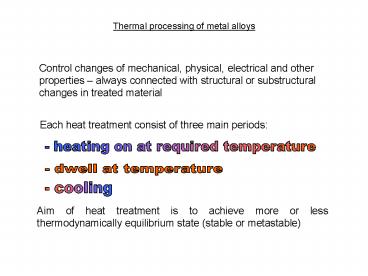Sn PowerPoint PPT Presentation
Title: Sn
1
Thermal processing of metal alloys
Control changes of mechanical, physical,
electrical and other properties always
connected with structural or substructural
changes in treated material
Each heat treatment consist of three main
periods
- heating on at required temperature
- dwell at temperature
- cooling
Aim of heat treatment is to achieve more or less
thermodynamically equilibrium state (stable or
metastable)
2
Thermal processing of metal alloys
- Heat treatment (temperature effect)
- annealing (to get more stable state)
- reduce internal stress, reach softer and
ductile structure, - hardening (to get metastable state)
- increases strength, hardness, wear
resistance, - Thermomechanical treatment
- (effect of temperature and deformation)
- control of final structure and mechanical
properties - Chemical heat treatment
- (effect of temperature and changes of the
chemical composition) - to get different properties of surface layer as
in core of the piece - higher hardness, better wear or corrosion
resistance,
3
Heat treatment of steels
Annealing
- Lower critical temperature (without
transformation) - Process (recrystallization) annealing
- Stress relief annealing
- Spheroidizing
- Upper critical temperature (partial or whole
transformation) - Normalizing
- Homogenization
4
Process (recrystallization) annealing 550 700
C, 1- 5 hours, cooling in air To change the
structure and properties of cold worked (strain
hardened) steel. Recovery and recrystallization
processes occur. Softening, increase ductility
and uniform fine grain structure is
achieved. Stress relief annealing 400 650 C,
2 - 10 hours, very slow cooling in
furnace Reduce internal residual stresses (after
machining, heat treatment, )
5
Spheroidizing (soft annealing) 700 C, 5 25
hours, slow cooling to 600 C in furnace, then
cooling may continue in air. Spheroidite
structure is developed
Used to improve machineability and toughness.
6
Normalizing 50 80 C above upper critical
temperature (phase diagram), cooling in
air. Austenitization of the steel is required and
cooling in accordance with CCT diagram to get
uniform and fine grain structure. Full annealing
over A3 and A1 with furnace cooling. Homogenizat
ion 1100 - 1200 C (200 C under solidus!) To
reduce structure and chemical composition
inhomogeneities after casting.
7
(No Transcript)
8
Hardening of steel
Purpose improve strength, hardness, wear
resistance,
Way Reach the martensite or bainite structure
or their combination
How By quenching
9
CCT diagram
10
CCT diagram
11
(No Transcript)
12
Hardenability of the steel
- The martensitic transformation have to bee
possible! - Carbon steel with at least 0,25 wt .
- Hardened structure contain at least 50 of
martensite. - Hardenability is defined by depth, in which the
- hardened structure is achieved.
13
Jominy end quench test
14
(No Transcript)

